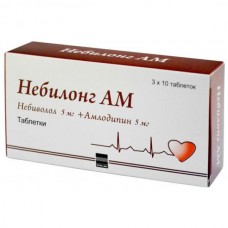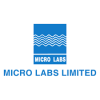Expiration date: 07/2026
Composition and form of issue
Nebilong pills
1 tab. contains nebivolol 2, 5, 5 and 10 mg, in a package of 10, 30 and 50 PCs.
Pharmacological action
Nebilong - cardioselective beta-blocker III generation with vasodilating properties. The active substance is a racemate consisting of two enantiomers: d-nebivolol and L-nebivolol. Nebivolol is a competitive and selective blocker of ?1-adrenoreceptors (affinity to ?1-adrenoreceptors 288 times higher than to ?2-adrenoreceptors), in addition, has a mild vasodilating effect by modulating the release of relaxing factor (NO) from the endothelial vessels. Nebivolol reduces heart rate and blood pressure at rest and during exercise, reduces end-diastolic pressure of the left ventricle, reduces systemic vascular resistance, improves diastolic heart function (reduced filling pressure) increases the ejection fraction, causing antianginal effect in patients with coronary artery disease. The optimal hypotensive effect is manifested after 1-2 weeks of treatment. In some cases, the maximum effect is achieved after 4 weeks.
Indications
Essential (primary) hypertension, coronary heart disease.
Contraindications
Bronchial asthma, chronic heart failure decompensation, untreated pheochromocytoma, severely impaired liver function, depression, angiospasticescoy angina (Prinzmetal's angina), obliterative diseases of peripheral vessels (an alternating lameness syndrome), hypotension, cardiogenic shock, bradycardia (heart rate less than 50 beats/min), SSSU, AV blockade II and III extent, myasthenia, muscular weakness, childhood and adolescence to 18 years, increased sensitivity to nebivolol.
Use during pregnancy and breast-feeding
Use during pregnancy is possible only on strict indications (due to the possible development of neonatal bradycardia, hypotension, hypoglycemia and respiratory paralysis). Reception of nebivolol should be discontinued 48-72 hours before delivery. In cases where this is not possible, close monitoring of newborns should be provided for 48-72 hours after birth.
Dosage and administration
Adults for oral administration-2.5-5 mg / day. in the morning. The optimal effect develops after 1-2 weeks of treatment, and in some cases - after 4 weeks. If necessary, the daily dose is increased to 10 mg/day. For patients over the age of 65, the initial dose is 2.5 mg / day. If necessary, the daily dose can be increased to 5 mg.
Side effect
From the Central and peripheral nervous system: headache, dizziness, fatigue, paresthesia, depression, decreased ability to concentrate, drowsiness, insomnia, nightmares, hallucinations.
From the digestive system: nausea, constipation, diarrhea, dry mouth.
From the cardiovascular system: bradycardia, orthostatic hypotension, shortness of breath, swelling, heart failure, AV blockade, heart rhythm disorders, Raynaud's syndrome, cardialgia.
Allergic reactions: skin rash.
Other: bronchospasm (including in the absence of obstructive pulmonary disease in history), photodermatosis, hyperhidrosis, rhinitis.
Special instruction
Nebilong is used with caution in patients with renal insufficiency, hyperthyroidism, allergic diseases, psoriasis, people over the age of 65 years and patients with diabetes. Cancellation of beta-blockers should be carried out gradually, within 10 days (up to 2 weeks in patients with coronary artery disease). At the beginning of treatment should be daily to control blood PRESSURE and heart rate. The effectiveness of beta-blockers in smokers is lower than in non-smokers. Nebivolol does not affect the level of glucose in patients with diabetes, but under the influence of nebivolol can be masked certain signs of hypoglycemia (tachycardia, heart palpitations), caused by the use of hypoglycemic drugs. If necessary, the use of nebivolol in patients with psoriasis should carefully evaluate the expected benefits of therapy and the possible risk of exacerbation of psoriasis. Beta-blockers should be used with caution in case of increased thyroid function due to the fact that under the influence of beta-blockers tachycardia can be leveled. Nebivolol can exacerbate the symptoms of peripheral circulatory disorders. Patients wearing contact lenses should take into account that the use of beta-blockers may reduce the production of lacrimal fluid. When carrying out surgical interventions, the anesthesiologist should be warned that the patient is taking beta-blockers. Control of glucose in the blood plasma should be carried out 1 time in 4-5 months (in patients with diabetes). Control of laboratory indicators of renal function should be carried out 1 time in 4-5 months (in elderly patients). Application in children is not recommended.
Interaction
While the use of antiarrhythmic drugs class I, amiodarone may increase the negative inotropic effects and inhibition of AV-conduction. While the use of calcium channel blockers (verapamil and diltiazem) increases the negative inotropic effect and inhibition of AV-conductivity. While the use of sympathomimetics is inhibited by the pharmacological activity of nebivolol. While the use of drugs for anesthesia may suppress reflex tachycardia and increase the risk of hypotension. While the use of tricyclic antidepressants, barbiturates, phenothiazine derivatives may increase the antihypertensive action of nebivolol. While the use of cimetidine may increase the concentration of nebivolol in blood plasma.
Overdose:
Symptoms: bradycardia, hypotension, bronchospasm and acute heart failure.
Treatment: in case of overdose or hypersensitivity reaction, the patient should be under the supervision of a doctor and receive treatment in the intensive care unit. It is necessary to determine the concentration of blood glucose. Gastric lavage, the appointment of a laxative and enterosorbents will prevent the absorption of drug residues in the gastrointestinal tract. In the treatment of bradycardia, atropine or methylatropine is prescribed. When hypotension is carried out exchange transfusion of plasma and administration of catecholamines. The effect of the blockade of ?-adrenergic receptors can be eliminated by slow in/in the introduction of isoprenaline hydrochloride, starting with a dose of 5 µg/min, or dobutamine, starting with a dose of 2, 5 µg/min, to obtain the desired effect. In the absence of effects should consider I/V administration of glucagon 50-100 µg/kg. If necessary, the injection can be repeated in an hour, followed by infusion of glucagon at a dose of 70 µg/kg/h.
Storage conditions
Store at a temperature not exceeding 25 °C in a dry place.


